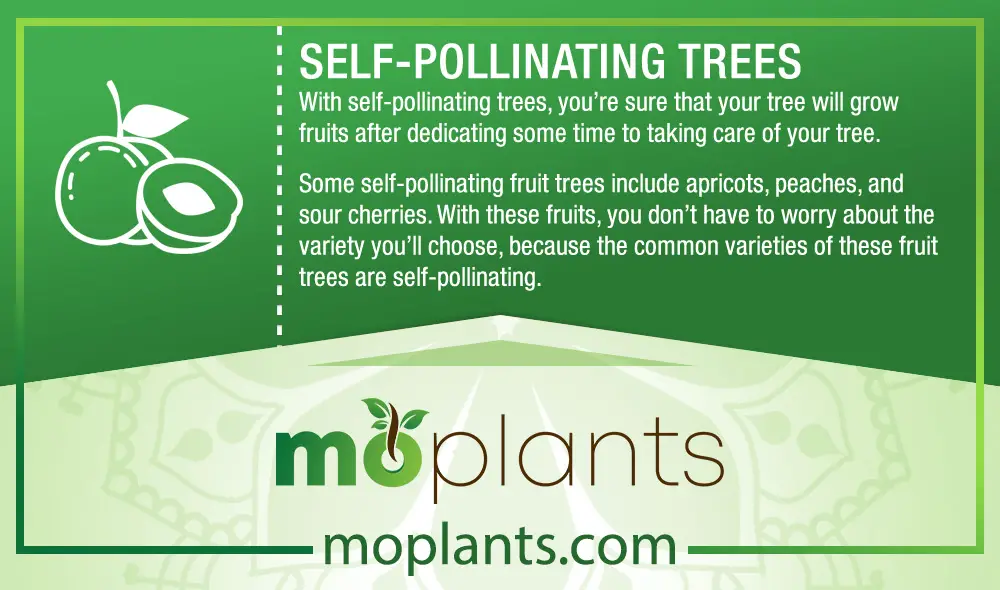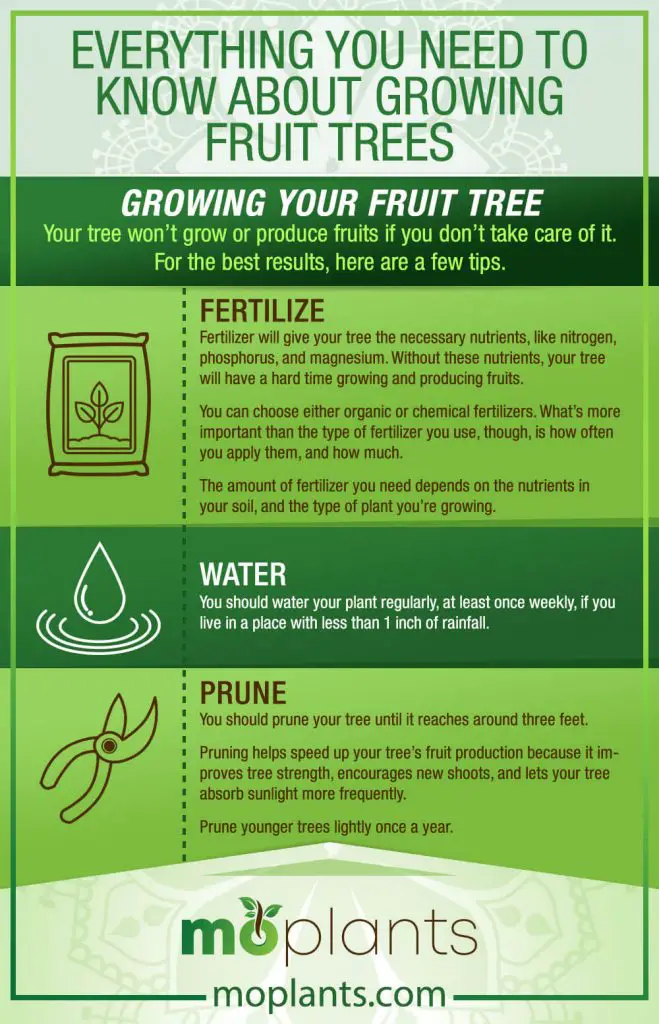A fruit tree can turn your backyard upside down and make it a better-looking place to live in. It also comes with a few pluses. Hand-picked fruit snacks, anyone?
Here, we have everything you’ll want to know about growing fruit trees.
Benefits of Growing Fruit Trees
There are plenty of reasons why you should try to grow your own fruit tree.
For starters, trees improve air quality. Plants are natural filters and can remove harmful pollutants from the air we breathe.
Having your own fruit trees can reduce your carbon footprint because you’ll be sourcing your fruits from your own backyard.
The global supply chain, which involves many steps from harvesting to packing, to shipping fruits, takes a huge toll on the environment, so you can do your part by planting fruit trees.
Fruit-Bearing Trees for Beginners
We’d love to tell you that planting trees is as easy as eating fruit and planting the seed in it, but it’s a bit more complicated than that.
Not all trees are created equal. Some kinds, like avocado trees, are hard to get fruits out of. It’s the same with apple trees, which are also not true to type.
“True to type” trees produce the same fruits as their parents. This means that no matter how hard you try, you might not get the same fruit from your seed as the one your seed came from.
You’ll be lucky if your apple is even edible.
Most commercial growers use the grafting technique to make trees produce fruit. Grafting is an old propagation technique that works by connecting a shoot (the “scion”) to a root piece (the “stock”).
If you want to make sure you’re planting a tree that will produce fruit, don’t bother starting from seeds or pits. Start with grafted fruit plants from your nursery or online instead.
How to Get Started
Choose a Suitable Planting Site
There are two important things you have to consider when you’re choosing a place to plant your fruit tree in: soil drainage and sun exposure.
Trees that grow in flooded soil die within a few years because it doesn’t give your plant roots enough room for growth.
Choose a spot in your backyard with good soil drainage. Well-drained soil is best for fruit trees because your fruit tree can receive ample hydration and nutrients without stunting root growth.
You should also look for a place in your backyard that receives full sun exposure. Your fruit trees need sun for at least 6 hours a day.\

Choosing Your Fruit Tree
Why Pollination Matters
Pollination is how trees can produce fruit. There won’t be any fruits around without fertilized plant ovaries, after all.
If this is your first shot at planting fruit trees, we suggest you choose self-pollinating trees and shrubs to start with.

Self-Pollinating Trees
With self-pollinating trees, you’re sure that your tree will grow fruits after dedicating some time to taking care of your tree.
Some self-pollinating fruit trees include apricots, peaches, and sour cherries. With these fruits, you don’t have to worry about the variety you’ll choose, because the common varieties of these fruit trees are self-pollinating.
If you want to grow pear trees, you’ll have to be more careful. Pear trees generally aren’t self-pollinating.
If you’re in California, you’re in luck: some pear varieties are self-fruitful, like the Bartlett and the Comice varieties.
If you want an easier tree to start with, you could give persimmons a shot.
Persimmons are easy to grow because they survive diverse soil conditions, they’re self-fruitful, and they can also cross-pollinate.

Cross-Pollinating Plants
If you can take on a challenge, then maybe you can try planting an apple tree.
Apple trees are challenging because they’re self-incompatible and will only grow fruit by cross-pollinating complementary varieties.
With apple trees, you can’t plant and grow just one. You’ll need at least two planted trees with similar bloom times to ensure maximum crop growth.

Bare-Root vs.Balled-and-Burlapped Tree
Besides choosing which fruit trees to get, you also have to decide whether you’ll plant fruit trees bare-root or balled-and-burlapped.
Balled-and-burlapped (B&B) saplings come with a ball of soil around their roots. Chances are if you buy a tree from a nursery, the sapling is likely B&B.
Container-grown plants are also similar to B&B saplings, except that your root ball will probably involve all the soil inside the container.
Root-ball saplings are easier to plant and are gentler on the tree root. All you have to do is to dig a hole in your backyard, place the root ball inside the hole, and backfilling that hole with your excavated soil.
Some gardeners like planting bare-root fruit saplings. Just like the name says, bare-root trees don’t have a ball of soil surrounding the roots.
A bare-root fruit tree will establish more quickly in the environment where it’s planted, so that’s one reason some gardeners prefer it. But the bare-root process could be dangerous to fragile tree roots.

Infographic

Preparing Your Soil for Planting
We recommend testing your soil first before planting, so you’re sure that you’re planting in a suitable spot. As a minimum, test for soil pH and nematodes.
Soil pH should be somewhere around 6.0 to 6.5 so that your trees absorb the right nutrients.
You should probably check for nematodes, too. Nematodes are parasites that spread viruses to fruit plants and can be dangerous to your fruit tree’s health and crop capacity.
The best kind of soil for fruit tree planting is loam because it’s well-draining.
You can use compost in the planting hole so that your plant roots can grow better, faster, and healthier.

When to Plant Fruit Trees
Spring is the season of fertility for a reason. The best time to plant your tree is in early spring.
It’s important to make sure that the ground is frost and flood-free before you start planting your tree, so don’t rush to plant on the first day of spring.
The earlier you get a head-start on planting and growing your tree, the better. Saplings planted earlier establish faster. Those planted later in the spring could grow slower compared to saplings planted earlier.

Infographic

Planting Day
The time has come. You prepared your soil, and you chose a glorious spot to plant your tree in your backyard.
You bought a low-maintenance, self-pollinating pear tree. You dug a spot deep enough to accommodate your pear tree.
What now?
Planting Container-Grown or B&B Fruit Trees
If you bought your sapling in containers, you have to take a few extra steps to ensure that your roots are healthy before planting them into the ground.
First, remove the plant from the container. Even if the container is “plantable,” this could choke your sapling’s root.
Next, if you see that the edges of your rootball are just a mass of exposed tangled roots, then shave off the outer inch of the ball with a sharp saw.
Place your tree in the hole after. Don’t make the mistake of planting the entire rootball in the excavation, or else you risk shortening your tree’s life expectancy.
Backfill the hole until the top of the rootball is two inches higher than the surrounding ground.
Afterward, water your tree. About five gallons of water should be enough to hydrate your tree. Larger trees need more water though, so check for the correct amount of water for your tree.
Growing Your Fruit Tree
Your tree won’t grow or produce fruits if you don’t take care of it. For the best results, here are a few tips.
Fertilize
Fertilizer will give your tree the necessary nutrients, like nitrogen, phosphorus, and magnesium. Without these nutrients, your tree will have a hard time growing and producing fruits.
You can choose either organic or chemical fertilizers. What’s more important than the type of fertilizer you use, though, is how often you apply them, and how much.
The amount of fertilizer you need depends on the nutrients in your soil, and the type of plant you’re growing.

Water
You should water your plant regularly, at least once weekly, if you live in a place with less than 1 inch of rainfall.

Prune
You should prune your tree until it reaches around three feet.
Pruning helps speed up your tree’s fruit production because it improves tree strength, encourages new shoots, and lets your tree absorb sunlight more frequently.
Prune younger trees lightly once a year.

Infographic

Conclusion
These days, it’s really easy to buy all kinds of fruits from the grocery store or your local farmer’s market. You can even order fruits online!
But there’s something different about enjoying the fruit of your own labor. We really think you should give fruit tree-planting a shot.

